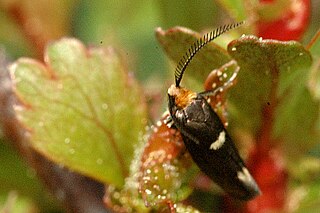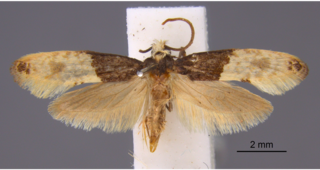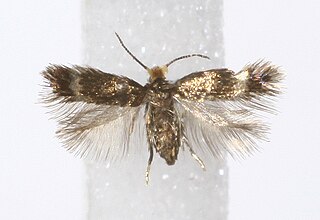
Cauchas rufimitrella is a diurnal lepidopteran from the family Adelidae, the fairy long horn moths. It is found in almost all of Europe, except Portugal, Ukraine and the southern part of the Balkan Peninsula.

Incurvaria masculella, the feathered leaf-cutter, is a moth of the family Incurvariidae. It is widespread in Europe.

Incurvaria pectinea is a moth of the family Incurvariidae. It is found in Europe.

Trichophaga tapetzella, the tapestry moth or carpet moth, is a moth of the family Tineidae, commonly referred to as fungus moths. It is found worldwide.

Adela croesella is a moth of the family Adelidae. It is found in most of Europe.

Phylloporia bistrigella is a moth of the family Incurvariidae. It is found in western, northern and central Europe and north-eastern North America.

Stigmella confusella is a moth of the family Nepticulidae. It is found from Fennoscandia to the Pyrenees, Alps and Bulgaria and from Ireland to central Russia.

Stigmella betulicola is a moth of the family Nepticulidae. It is found in most of Europe, east to the eastern part of the Palearctic realm.

Stigmella alnetella is a moth of the family Nepticulidae. It is found in all of Europe, except the Balkan Peninsula.

Stigmella continuella is a moth of the family Nepticulidae. It is found from Fennoscandia to the Pyrenees, Alps and Hungary, and from Ireland to central Russia and Ukraine, east to the eastern part of the Palearctic realm.
Stigmella filipendulae is a moth of the family Nepticulidae. It is found from Fennoscandia to the Alps and the Carpathians, and from Ireland to Poland. There is a disjunct population in Greece.

Stigmella glutinosae is a moth of the family Nepticulidae. It is found in all of Europe.

Bohemannia quadrimaculella is a moth of the family Nepticulidae. It is found from Norway and Sweden, south to France and from Ireland, east to the Czech Republic and Austria. It has also been recorded from Romania.

Incurvaria praelatella is a moth of the family Incurvariidae. It is found in all of Europe, except the Iberian Peninsula.

Nemophora cupriacella is a moth of the family Adelidae that is found in most of Europe.

Coptotriche marginea is a moth of the family Tischeriidae, found in most of Europe. It was named by the English botanist, carcinologist and entomologist, Adrian Hardy Haworth in 1828, from a specimen found in England. The larvae mine the leaves of brambles (Rubus) species.

Scrobipalpa costella is a moth of the family Gelechiidae. It is found in western Europe.

Nemophora minimella is a moth of the Adelidae family. It is found in most of Europe, except Estonia, Ukraine, Slovenia, Switzerland and Portugal.

Bryotropha umbrosella is a moth of the family Gelechiidae. It is found in open dune areas throughout most of north-western Europe. In southern Europe, it is only known from one record from Spain.

Eulamprotes atrella, the two-spotted neb, is a moth of the family Gelechiidae. It was described by Michael Denis and Ignaz Schiffermüller in 1775. It is found from most of Europe, east to Japan. The habitat consists of mixed deciduous woodlands.

















